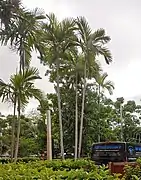Ptychosperma elegans
Ptychosperma elegans is a very slender palm endemic to the Northern Territory and eastern Queensland in Australia.[2] It has the common names of Alexander palm,[3] Solitaire palm, cabbage palm, and elegant palm.
| Ptychosperma elegans | |
|---|---|
 | |
| Scientific classification | |
| Kingdom: | Plantae |
| Clade: | Tracheophytes |
| Clade: | Angiosperms |
| Clade: | Monocots |
| Clade: | Commelinids |
| Order: | Arecales |
| Family: | Arecaceae |
| Genus: | Ptychosperma |
| Species: | P. elegans |
| Binomial name | |
| Ptychosperma elegans | |
| Synonyms | |
| |
The palm's native habitats are coastal rainforests in northern Australia.[4] It has been naturalized in South Florida since at least the 1950s, and remains the only member of its genus naturalized in the USA. Due to its intolerance of cold, it is mostly found in South Florida and coastal Tampa. It also is used in Coastal Southern California, primarily Orange and San Diego counties.
Cultivation
Ptychosperma elegans is cultivated as an ornamental tree for planting in temperate climate gardens and parks.[5] It is a single trunked tree, that in cultivation can reach 20–40 feet (6.1–12.2 m) in height.[4]
The trunk is 1–4 inches (2.5–10.2 cm) in diameter. It is light gray or almost white, with dark leaf base scars encircling the trunk.[6]
The pinnately compound leaves or fronds can reach lengths of 6–8 feet (1.8–2.4 m) and are attached to a 1 foot (0.30 m) long petiole. They are dark green on the top and gray-green on the underside.[6]
Inflorescences produce white male and female flowers. Fruits are bright red, about one inch in diameter, and egg shaped.[4][6]
Gallery
 Group of Mature Ptychosperma elegans in Miami Florida.
Group of Mature Ptychosperma elegans in Miami Florida. Ptychosperma elegans laden with seeds.
Ptychosperma elegans laden with seeds. Group of Ptychosperma elegans in Englewood Florida.
Group of Ptychosperma elegans in Englewood Florida.
See also
- Archontophoenix alexandrae — also has Alexander palm as common name
- Adonidia — a palm genus with similar appearance
References
- F.M. Bailey Cat. Pl. Queensland 50 1890
- "Ptychosperma elegans". Germplasm Resources Information Network (GRIN). Agricultural Research Service (ARS), United States Department of Agriculture (USDA). Retrieved 14 January 2018.
- "Ptychosperma elegans". Natural Resources Conservation Service PLANTS Database. USDA. Retrieved 15 October 2015.
- Pacsoa.org.au: Ptychosperma elegans
- Dave's Garden Blog: Solitaire Palm (Ptychosperma elegans)
- Palmpedia: Ptychosperma elegans
External links
- PACSOA—Palm and Cycad Societies of Australia wiki: Ptychosperma elegans (Solitaire palm) — with images
- USDA Plants Profile for Ptychosperma elegans (Alexander palm)
| Wikimedia Commons has media related to Ptychosperma elegans. |